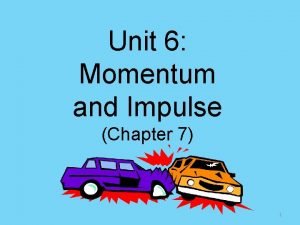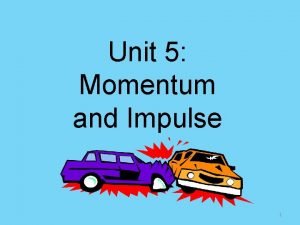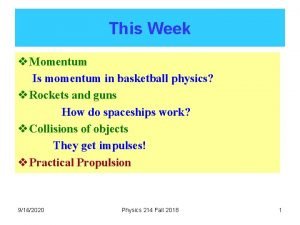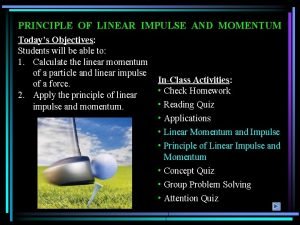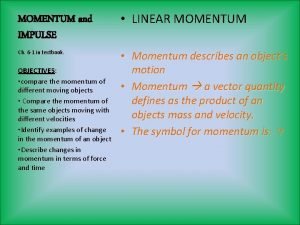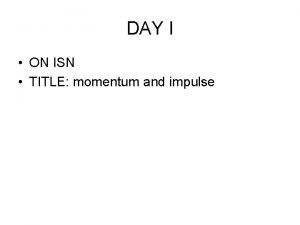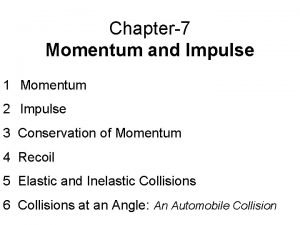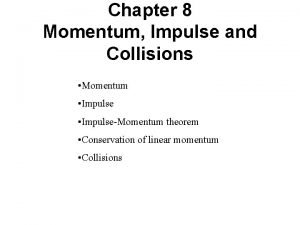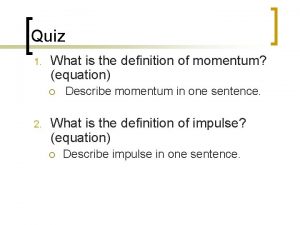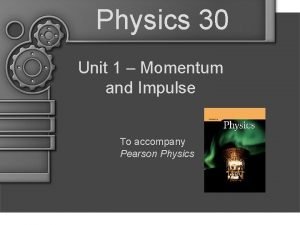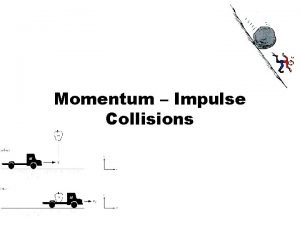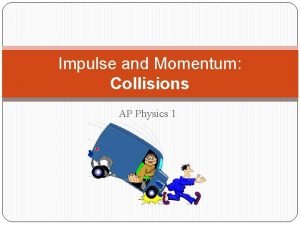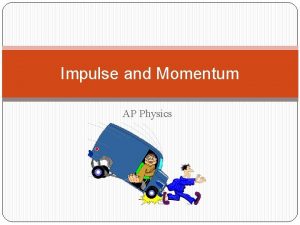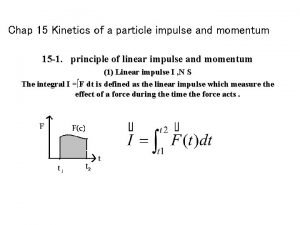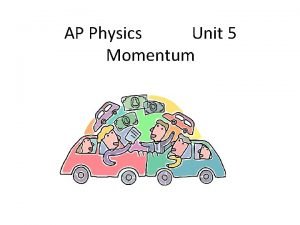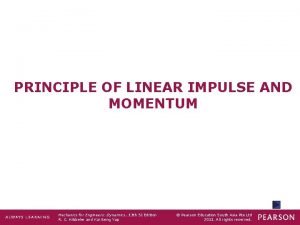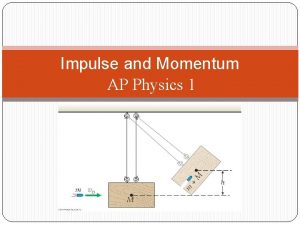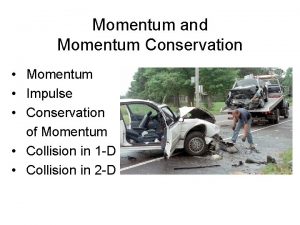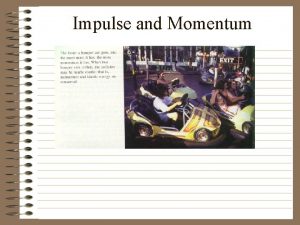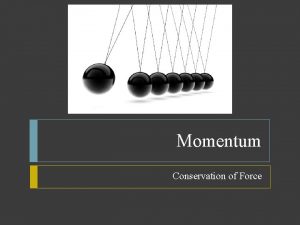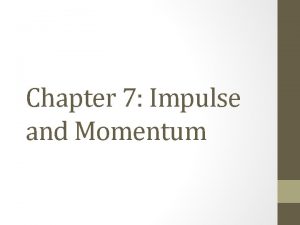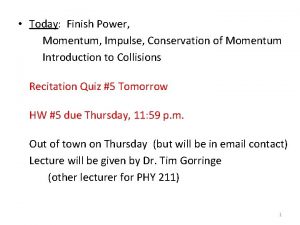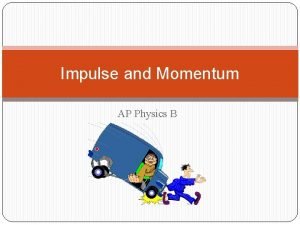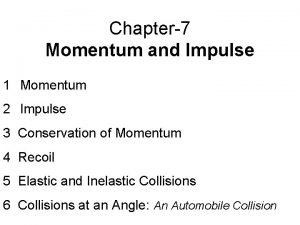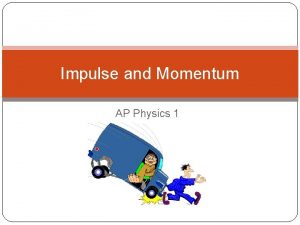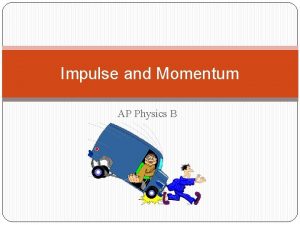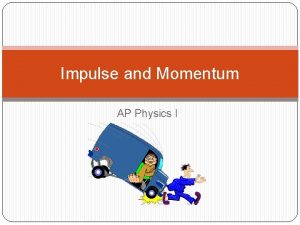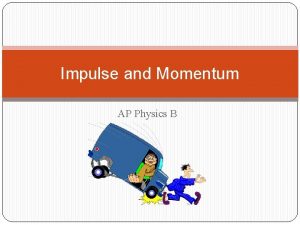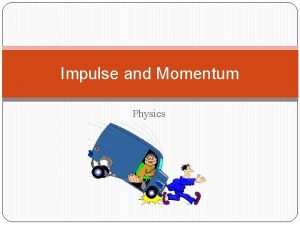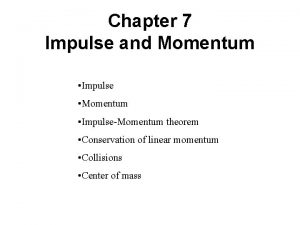Today Ch 7 Momentum and Impulse Conservation of


























- Slides: 26

Today: (Ch. 7) è Momentum and Impulse è Conservation of Momentum è Collision

Momentum • The momentum of a particle depends on its mass and velocity • Momentum is defined as – The direction of the momentum is the same as the velocity – Units are kg m / s

Momentum of a System • To find the total momentum of a system of particles, you need to add the momenta of all the individual particles in the system • – The particles may be pieces of a solid object or individual particles associated with each other

Magnitude and direction of momentum Two particles of mass m 1 = 1. 9 kg and m 2 = 2. 5 kg are traveling with velocities v 1 = 4. 9 m/s, and v 2 = 2. 8 m/s as shown in the figure below. What is the total momentum of this system? Be sure to give the magnitude and direction of the momentum. For direction give the angle made with x-axis.

Force and Momentum • Assume the force and acceleration are constant • • Since momentum is mass times velocity, the force can be related to the momentum • • – This is the impulse theorem

Impulse and Average Force • It may be difficult to calculate the form of the force-time curve • Often the time interval is very small – Example bat hitting ball • The average force can be used to find the impulse •

Force and impulse A constant force of magnitude 34. 5 N acts on an object for 5. 3 s. What is the magnitude of the impulse?

Conservation of Momentum • Impulse and momentum concepts can be applied to collisions • The total momentum just before the collision is equal to the total momentum just after the collision • The total momentum of the system is conserved

Momentum and External Forces • The interaction forces between particles in a system do not change the momentum of the system • External forces may act from outside the system • The external forces may cause the particles to accelerate and therefore the momentum is not conserved – In many cases, the external force is very small when compared to the collision forces – Then assuming momentum is conserved is still a useful way to analyze collisions

Collisions • A collision changes the particles’ velocities • The kinetic energies of the individual particles will also change • Collisions fall into two categories – Elastic collisions • The system’s kinetic energy is conserved – Inelastic collisions • Some kinetic energy is lost during the collision • Momentum is conserved in both types of collisions

Energy in Collisions • Elastic collisions – Kinetic energy is converted into potential energy and then back into kinetic energy – So kinetic energy is conserved • Inelastic collisions – If the object does not return the kinetic energy to the system after the collision, the collision is inelastic – The kinetic energy after the collision is less than the kinetic energy before the collision

Problem Solving • Recognize the principle – The momentum of the system is conserved when the external forces are zero – Conservation of Momentum can be applied when the collision force between the particles is much larger than the external forces • Sketch the problem – Make a sketch of the system – Show the coordinate axes – Show the initial and final velocities of the particles in the system • When given

Problem Solving, cont. • Identify the relationships – Write the conservation of momentum equation for the system – Is the kinetic energy conserved? • If KE is conserved, then the collision is elastic – Write the kinetic energy equation for both particles – Use the system of equations to solve for unknown quantities • If KE is not conserved, then the collision is inelastic – Solve for the unknown using conservation of momentum equation • Check – Consider what your answer means – Check that the answer makes sense

Elastic Collision Example • Recognize the Principle – External forces are zero – Total momentum is conserved • Sketch the problem – Shown to the right – Everything is along the xaxis

Elastic Collision Example, cont. • Identify the relationships – Elastic collision, so kinetic energy is conserved – Equations: • Solve for the unknowns

Inelastic Collisions in One Dimension • In many collisions, kinetic energy is not conserved – The KE after the collision is smaller than the KE before the collision • These collisions are called inelastic • The total energy of the universe is still conserved – The “lost” kinetic energy goes into other forms of energy • Momentum is conserved • Momentum gives the following equation: – Leaves two unknowns

Completely Inelastic Collisions • In a completely inelastic collision, the objects stick together • They will have the same velocity after the collision • Therefore, there is only one unknown and the equation can be solved

Kinetic Energy in Inelastic Collisions • Although kinetic energy is not conserved, total energy is conserved • The kinetic energy is converted into other forms of energy – These could include • Heat • Sound • Elastic potential energy

Inelastic collision in one dimension Two objects of mass m 1 = m (speed v 1) and m 2 = 9 m (speed v 2) undergo a completely inelastic collision in one dimension. If the two objects are at rest after the collision, what was the ratio of their speeds (v 1/v 2) before the collision?

Collisions in Two Dimensions • The components of the velocity must be taken into account • The momentum conservation includes both components of the velocity • Follow the general problem solving strategy – Include any additional information given – Is the collision elastic? • If yes, kinetic energy is conserved • If not, is there any information about one of the final velocities?

Collision in Two Dimensions • The system is two colliding particles – Rocket and asteroid – External forces are gravity from the Sun and Earth • Small compared to the forces involved in the collision, so it is correct to assume momentum is conserved • Choose the initial velocity of the asteroid as the +y direction • Choose the initial velocity of the rocket as the +x direction • The rocket and the asteroid stick together, so it is a completely inelastic collision • Write the conservation of momentum equations for each direction • Solve for the final velocity

Conservation of Momentum and Analysis of Inelastic Events • In all the previous examples, mass has been conserved • The principle of conservation of momentum can be applied in situations where the mass changes • Such problems can be viewed in two ways: – An object whose mass abruptly increases – A collision between the original object and the added mass • In both cases, conservation of momentum can be applied

Changing Mass Example • Treat the car as an object whose mass changes • Can be treated as a onedimensional problem • The car initially moves in the x -direction • The gravel has no initial velocity component in the xdirection • The gravel remains in the car, the total mass of the object is the mass of the car plus the mass of the gravel

Changing Mass Example, 2 • Treat the problem as a collision • The gravel remains in the car, so it is a completely inelastic collision • The gravel has no momentum in the x-direction before the collision • In both cases, • Momentum is not conserved in the y-direction – There are external forces acting on the car and gravel

Water accumulation in a moving car An open railroad car of mass 2495 kg is coasting with an initial speed of 19 m/s on a frictionless, horizontal track. It is raining, and water begins to accumulate in the car. After some time, it is found that the speed of the car is only 10 m/s. How much water (in kilograms) has accumulated in the car?

Tomorrow: (Ch. 7) Momentum, Impulse, and Collisions continued……….
 Physics 03-06 impulse and momentum answer key
Physics 03-06 impulse and momentum answer key Unit 6 momentum and impulse
Unit 6 momentum and impulse Impulse law
Impulse law Impulse and momentum in basketball
Impulse and momentum in basketball Principle of linear impulse and momentum
Principle of linear impulse and momentum Linear impulse equation
Linear impulse equation Importance of momentum
Importance of momentum Use of momentum and impulse as safety equipment in vehicles
Use of momentum and impulse as safety equipment in vehicles Impulse and momentum relationship
Impulse and momentum relationship Importance of momentum and impulse
Importance of momentum and impulse Momentum and impulse formula sheet
Momentum and impulse formula sheet Unit for momentum
Unit for momentum Units momentum
Units momentum Momentum units
Momentum units Physics 30 momentum and impulse unit exam
Physics 30 momentum and impulse unit exam What is the change in momentum
What is the change in momentum Mel physics
Mel physics Define linear momentum and impulse
Define linear momentum and impulse Impulse and momentum
Impulse and momentum Impulse and momentum ap physics 1
Impulse and momentum ap physics 1 Example for impulsive force
Example for impulsive force Collision
Collision Kinetics of a particle: impulse and momentum
Kinetics of a particle: impulse and momentum Physics
Physics Dynamics impulse and momentum solved problems
Dynamics impulse and momentum solved problems Principle of angular impulse and momentum
Principle of angular impulse and momentum Ap physics momentum and impulse
Ap physics momentum and impulse

